#lesser known figures from mythology
Explore tagged Tumblr posts
Text
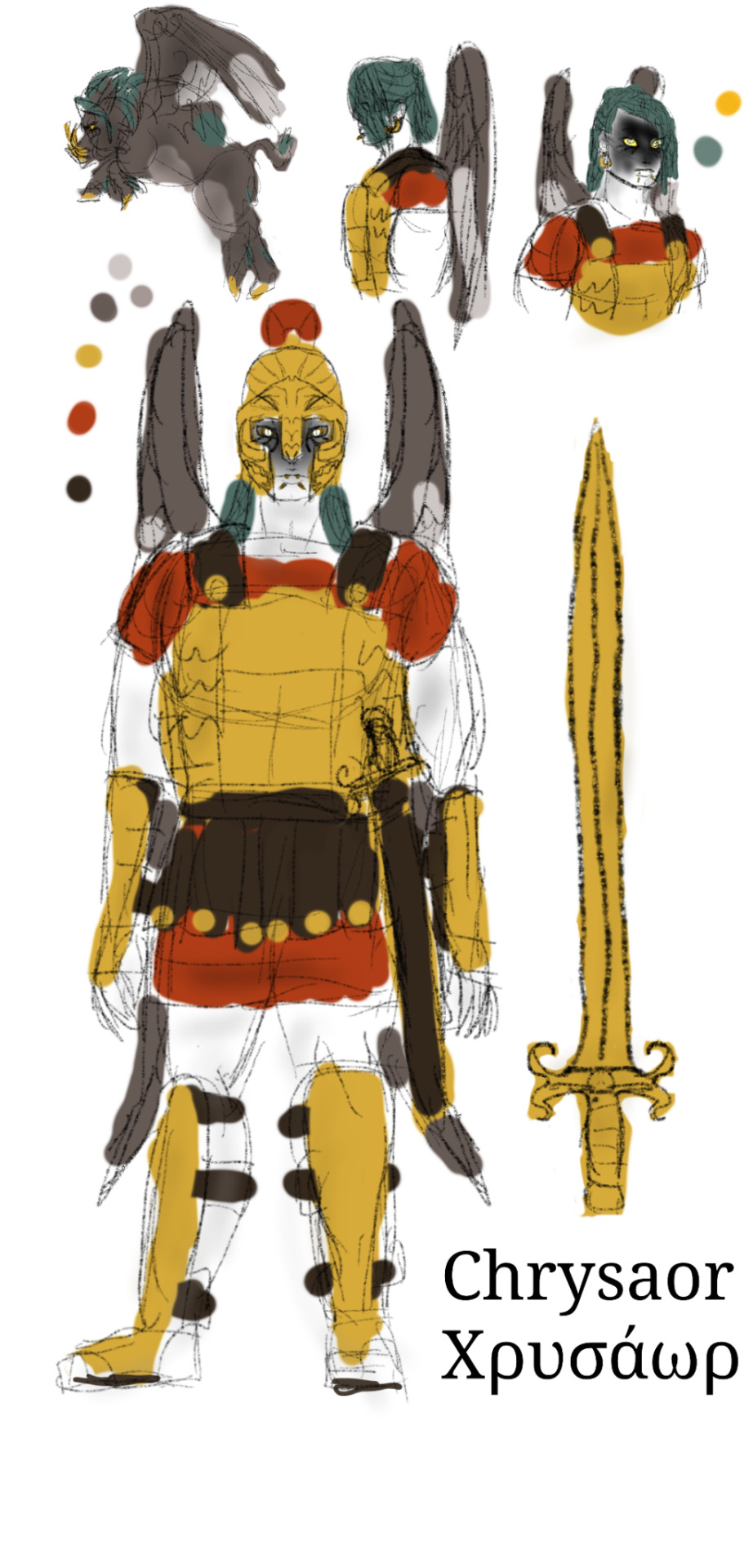
Made rough concept art of Chrysaor, the son of Medusa & Poseidon. He's sometimes discribed as a gaint warrior with a golden sword, or a winged boar with golden tusks. I imagine he usually looks humaniod with wings, & golden serpent eyes like his mother, Medusa, but often takes the winged boar form when needed (or to just chill with his twin bro Pegasus).
While he's less well known than his twin brother Pegasus, he's a fierce warrior as well as a devoted husband to his Oceanid wife, Callirhoe. Tbh most folks are probably more familair with his kids, Geryon, the 3 headed gaint with a prize herd of cattle Hercules fought for his 10 labor. As well as his daughter Echidna, the infamous Mother of Monsters.
Tbh it's a shame his kids turned out like that. Despite Chrysaor having a terrifying gaze, which makes it hard for most people to look at him. So I depicted his face mostly in shadow, other than his eyes and mouth. Tbh he's actually pretty handsome & looks a lot like his dad Poseidon if u belive his wife, aunts, & step-mom Amphitrite, since they're some of the few people able to look directly at his face. I headcanon Chrysaor was actually pretty soft spoken & friendly guy. Don't get me wrong he was still a terrifying warrior on the battle field, he did train & become close with his cousin Ares after all. He probably would have been happier if he got the chance to stay with his wife & kids & became a house husband (altho a very intimidating & terrifying looking one). Unfortunatliy his dad is Poseidon, lord of the seas & an Olympian so Chrysaor is kind of pressured into seeking honor & glory.
#greek mythology#fanart#rough concept art#chrysaor#lesser known figures from mythology#shame this dude isnt as well known as the rest of his family#but maybe chrysaor never wanted to be a hero?#maybe he just wanted to be a good dad & husband but had to live up to his own divine fathers legacy#rip chrysaor u would have loved gokushufudo/way of the house husband
25 notes
·
View notes
Text

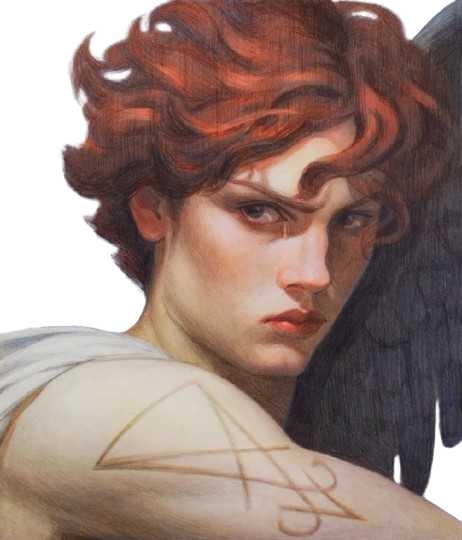


.。*♡゚ Much is said about Lucifer, how he fell from the heavens for rebelling. But little is known about his vast history, so I decided to make a post to comment a little. It's not like I know everything, there's still a lot I need to research, but research is ongoing, so I'll probably update this post as I learn new things about him.
First of all, Lucifer was not always an "evil name". Canonized by the Catholic Church - although many do not know him - Saint Lucifer was a bishop of the Archdiocese of Calhari, in Sardinia. He became well known for his staunch opposition to Arianism, an anti-Trinitarian Christological view held by the followers of Arius, a Christian priest of Alexandria in the times of the early Church.
Arius denied the existence of consubstantiality between Jesus and God, conceiving Christ as a pre-existent and created being, subordinate to God and his son. For Arius and the Arians, Jesus was not God but rather a man who descended from him, like all others who walked the Earth. Therefore, for Saint Lucifer, Jesus was God made flesh, the creator himself manifested in matter.
His name shows that Lucifer was not, at least in the 4th century, a synonym for "Adversary". In fact, the proper name "Lucifer" was not used to refer to the "devil" in ancient times. Before, the word was used only in its common meaning, as something that announced the dawn, the morning star. Nothing more, nothing less.
His name literally comes from the Latin Lux (Light) and Ferre (Bearer).
The word "lucifer" is a common noun, meaning "light-bearer" or "morning star". It is "lucifer" with a lowercase "l", unlike the proper name, "Lucifer". Incidentally, this is not the only occasion in which the term "lucifer" is used with this meaning.
The Vulgate of Saint Jerome includes, in the book of Job, the word "lucifer" (cf. Job 11:17), which is translated as "dawn" in the edition of João Ferreira de Almeida itself.
Saint Peter, when referring to the voice of God the Father confirming the mission of Jesus, asks that the words of the prophecy be held firm, "donec dies illucescat, et lucifer oriatur in cordibus vestris – until the day dawns and the morning star rises in your hearts" (2 Pt 1:19).
"Lucifer," as the entity we know, is not in the Bible. In Isaiah 14:12, the Hebrew word is celestial. Significantly, "star of man," it is clearly a reference to Venus — the planet with which Lucifer is most associated. The text itself is about the king of Babylon and does not refer to the "Adversary" of the Bible.
Jewish sources generally do not identify the figure in Isaiah as being a reference to Satan or any other kind of demonic figure, but later Christian scholars started to interpret it as a reference to Satan, who is elsewhere said to be cast down from heaven, although at first, it looks like they did not see "Lucifer" as a name, but read the passage as being a poetic comparison to the morning star itself.
These interpretations have fallen in and out of favor, but in the Renaissance, it became more popular to use Lucifer as a personal name of the devil.
"Lucifer" is the Latin term that Jerome used in the Vulgate to translate helel. Most moderns believe that Isaiah is using a well-known mythological tale as an analogy to the failure and consequences of the rebellion and king of Babylon.
According to Canaanite history, the morning star is personified as the god Attar, who attempted to occupy the throne of Baal and, finding himself unable to do so, descended and ruled the underworld. The original myth may have been about the lesser god Helel attempting to dethrone the Canaanite supreme god El, who lived on a mountain to the north.
Hermann Gunkel's reconstruction of the myth told of a mighty warrior named Hêlal, whose ambition was to ascend higher than all the other star deities, but who had to descend into the depths; thus, he portrayed as a battle the process by which the bright morning star fails to reach the highest point in the sky before being extinguished by the rising sun.
In Greco-Roman civilization, Lucifer was the name of the planet Venus when it appeared in the morning. It corresponds to the Greek names Phosphorus ("light-bearer") and Eosphorus ("dawn-bearer").
The Latin name of the entity was later absorbed into Christianity as a name for the devil. Modern scholarship generally translates the term in the relevant biblical passage (Isaiah 14:12), where the Greek Septuagint reads ὁ ἑωσφόρος ὁ πρωὶ ἀνατέλλων, as "morning star" or "shining one" rather than a proper name, Lucifer, as found in the Latin Vulgate.
In LaVeyan Satanism, Lucifer is described by The Satanic Bible as one of the four crown princes of hell, particularly that of the East, the 'lord of the air', and is called the bringer of light, the morning star, intellectualism, and enlightenment, which its true. He rules over those aspects and more.
As a name for the planet in its morning aspect, "Lucifer" (Light-Bearer) is a proper name. In Greco-Roman civilization, he was often personified and considered a god and in the Roman version considered the son of Aurora and Cephalus or, in his Greek counterpart, Eos and Helios. At that time, he was represented as a boy bearing a torch.
Regardless of the version, as the Lord of Light and Knowledge, Lucifer is demanding of his followers, but kind and gentle - he has a very cute epithet, which is the sweet prince. Lucifer is nothing if not charming, a protector who always works to help you become better. Growth is constant, Lucifer is the epitome of growth, direct and sweet at the same time, telling you what you need to do and letting you figure out how to do it.
How did such an entity have its image distorted to what we know today?
In the Book of Isaiah, chapter 14, the king of Babylon is condemned in a prophetic vision by the prophet Isaiah and is called הֵילֵל בֶּן-שָׁחַר (Helel ben Shachar, Hebrew for "the bright one, son of the morning"), who is addressed as הילל בן שחר (Hêlêl ben Šāḥar).
The title "Hêlêl ben Šāḥar" refers to the planet Venus as the morning star, and this is how the Hebrew word is usually interpreted. The Hebrew word transliterated as Hêlêl or Heylel occurs only once in the Hebrew Bible. The Septuagint translates הֵילֵל in Greek as Ἑωσφόρος (Heōsphoros), "bringer of the dawn", the ancient Greek name for the morning star.
Similarly, the Vulgate translates הֵילֵל in Latin as Lucifer, the name in that language for the morning star. According to Strong's Concordance based on the King James Bible, the original Hebrew word means "shining one, light-bearer," and the English translation given in the King James text is the Latin name for the planet Venus, "Lucifer," as it was already in the Wycliffe Bible.
The morning star metaphor that Isaiah 14:12 applied to a king of Babylon gave rise to the general use of the Latin word for "morning star/lucifer", capitalized, as the original name of the devil before his fall, linking Isaiah 14:12 with Luke 10 ("I saw Satan fall like lightning from heaven") and interpreting the passage in Isaiah as an allegory of Satan's fall from heaven.
Considering pride as a grave sin that reaches its peak in self-deification, Lucifer (Hêlêl) became the model for the devil. As a result, Lucifer was identified with the devil in Christianity, but what really perpetuated his image as king of demons, during the Renaissance, it became more poplar to use Lucifer as the devil's name; it used to pops up in a lot of Christian popular literature, such as Dante Alighieri's Inferno, Joost van den Vondel's Lucifer, and John Milton's Paradise Lost.
Early medieval Christianity made a strong distinction between Lucifer and Satan. While Lucifer, as the devil, is fixed in Hell, Satan carries out Lucifer's desires as his vassal. In true, Satan is a title, derived probably from the word Shaitam, and it means Adversary.

You can read about his other origins here
#demonolatry#lucifer deity#lucifer devotee#lucifer#luciferian#luciferian witch#deity work#witchblr#witchcraft#paganism
301 notes
·
View notes
Note
Do you have a list of tags for alternative universe with their meanings? (ex. angst, bittersweet, drama, etc).
Examples of AU Tags
Angst - In writing: when an author focuses on the anxieties, fear, and sense of dread of their characters, typically at the expense of the character’s hopes and wishes. You’ll find many main characters carry a sense of angst about their existence.
Apocalypse - An apocalypse AU story is often set during or after some sort of apocalypse, or end of the world.
Bittersweet - Or bittersweet ending; if the characters are better off (or at least status quo is preserved), but the story still ends on a melancholy note, it's a Bittersweet Ending. Another way to think of it is if the story's main conflict is resolved in favor of the protagonists, but at great sacrifice.
Coffee Shop - In most cases, one half of the main pairing is the barista and the other is or becomes their favorite customer; in some stories the whole cast works at a coffee shop.
Comedy/Humor - Shows the humor of characters, typically when they try to solve social, personal, or religious problems; meant to illicit laughter from the readers.
Crack - Crack fics are basically humorous stories that don’t have an ounce of coherency to them.
Cute/Fluff - Cute, low-conflict fanfiction, often romantic.
Drama - Contains conflict of characters.
Hurt/Comfort - Fanfiction in which a character suffers and is then comforted and/or helped to recover by other characters. You might also see a fic described as hurt, no comfort if there’s no recovery aspect.
Identity/Self-Discovery - Understanding oneself, personal transformation, and self-acceptance.
Magic - Magic AUs are alternate universe fanworks that incorporate magic in fandoms where there is no magic present in canon.
Mythology - Mythology AUs often involve re-imagining a character or characters as a mythological figure, usually a God or Goddess. Creators usually take their inspiration from Greek or Roman Mythology, but works building on Norse myths, Celtic mythology and folklore, and lesser known mythologies also appear.
Noir Detective - Stories in fanfic are usually either realized as complete AUs, in which the characters are put in a typical '40s-'50s film noir environment; or as a homage towards the style, in which the characters are still their canon selves, but plot or aesthetics are given a noir slant.
Nostalgia - Longing for the past, sentimental memories, and how looking back can be both comforting and painful.
OTP - Short for one true pairing. Used to mean ‘this is my favourite ship for this canon’ or occasionally ‘I can’t envision the characters in this ship with anyone else’.
Power/Corruption - The abuse of power, political corruption, and its impact.
Revenge - The pursuit of justice, vengeance, and its consequences.
Royal - A Royalty AU is a fanwork set in an alternate universe where one or more characters (who canonically aren't) are members of a royal family.
Smut - Smut fics are characterised by raunchy activities and sexual content. Fics that fall into this realm tends to focus more on the sexual part of a relationship between characters, often putting this fic into M18 territory.
Steampunk - A type of story which features anachronistic technology, usually futuristic adaptions of modern creations into Victorian or Wild West era steam-powered technology. Is a common subgenre of the Science Fiction & Fantasy world, both in and out of fandom.
Survival - Overcoming obstacles, resilience, and the fight for existence.
Time Travel - Character(s) travel backwards (or possibly forwards, though that is rarer) in time to either relive or rewrite history. Is a form of AU that sticks close to canon, but still allows for change due to the Alternate Timeline. Time Travel itself may be achieved through magic or science, or even completed unexplained reasoning.
Tragedy - Downfall, loss, suffering, and the inevitability of fate, often leading to catharsis for the audience.
Victorian - The most commonly used term for fanworks that take characters from a modern or future-set fandom and relocate them to a stereotypical Victorian romanticism era setting. It is a form of historical AU.
Whump - Fanfiction in which a character suffers gratuitously. It’s worth noting that the sufferer is often the author’s favourite character; whump isn’t usually written as an expression of dislike. Fanfiction about the gratuitous suffering of a character the author dislikes, which tends to be more mean-spirited in tone, is usually called character bashing instead.
Sources: 1 2 3 4 5 6 7 8 9 10 11 ⚜ More: Notes ⚜ Writing Resources PDFs
You can find more information and examples in the sources. Hope this helps with your writing!
#alternate universe#writing ideas#tropes#writing reference#writeblr#literature#dark academia#writers on tumblr#spilled ink#writing prompt#creative writing#light academia#writing inspiration#writing resources
78 notes
·
View notes
Photo

Native American Trickster Tales
The trickster figure of Native American literature was first popularized by the American anthropologist Paul Radin (l. 1883-1959), who highlighted the cultural/mythological character developed by many Native American nations as a supernatural entity primarily associated with transformation. The trickster figure appears in the legends of Native peoples of North America from coast to coast.
The following collection presents some of the most famous – as well as lesser known – tales featuring the trickster figure, who appears in various forms and is sometimes a hero, a villain, a fool, a wise man, a rogue, a clown, a champion, or a victim. The various roles of the trickster suggest his nature as an agent of transformation. Tales were fashioned to encourage an audience to consider their own behavior and change whatever aspects in themselves that they found offensive in the trickster or, in the stories where he appears as the hero, to model their outlook and actions on his own.
Continue reading...
74 notes
·
View notes
Text
The Exclusion of Greek Actors in Greek Mythology Films: An Issue in Hollywood Casting


The dismissal of Greek actors from playing roles in films about their own history and mythology is a recurring issue that often goes unnoticed or is simply excused. The comments in the provided image reflect a mindset that normalizes this exclusion, either due to ignorance or indifference.
1. Hollywood’s Profit-Driven Casting and the Erasure of Authenticity
Hollywood functions as a business, and the primary concern of major studios is maximizing profits. This often means prioritizing well-known, bankable actors over authenticity. While financial success is an understandable goal, it becomes problematic when it leads to the systematic erasure of actors from the very cultures being represented.
A major Hollywood production about Greek mythology will almost always feature a cast composed primarily of American, British, or Australian actors. The argument in favor of this approach is that these actors are "recognizable" and will attract audiences. However, this logic only holds because Hollywood itself creates and reinforces this system. If Greek actors were given opportunities in major films, they too could become well-known on an international level. The cycle of exclusion ensures that Greek actors remain unknown outside of Greece, making it impossible for them to reach a point where they are considered "bankable."
2. The Hypocrisy of Selective Authenticity
Hollywood often claims to prioritize historical or cultural accuracy when it suits them, but fails to apply the same standard to casting. For example, a Greek mythology film may feature meticulously researched armor and settings, yet the actors speaking and portraying these legendary figures have no connection to the culture that birthed these stories.
When other countries produce films about their national history or mythology, they naturally cast actors from their own nation. French films about Joan of Arc, Japanese samurai films, or Chinese historical dramas all prioritize actors from their respective cultures. Yet, when it comes to Greece, this standard is dismissed. Why is it acceptable for Greek figures to be portrayed exclusively by non-Greek actors? This reveals a deeper issue: Hollywood does not value Greek representation in a way that it does for other cultures with strong cinematic industries.
3. Dismissing Greek Actors Due to Lack of "Fame" is a Circular Argument
One of the comments in the image states, “A movie with this budget is NOT going to cast a bunch of actors that are only famous in Greece. That would be box office poison.” This argument is flawed for several reasons.
First, actors from other countries have often gained international recognition precisely because Hollywood took a chance on them. Spanish, Mexican, Danish, and South Korean actors have all managed to break into Hollywood because they were given the opportunity. Pedro Pascal, Antonio Banderas, and Mads Mikkelsen, for example, were not widely known in Hollywood before getting roles in major productions. The same chance is rarely given to Greek actors, which keeps them from gaining international recognition.
Second, casting unknown or lesser-known actors has never stopped films from succeeding. Many successful films have been led by relatively unknown actors who rose to fame through their roles. The argument that Greek actors shouldn’t be considered simply because they aren’t already famous ignores how fame is created in the first place—through opportunity.
4. Indifference as a Form of Complicity
Another issue evident in the comments is the attitude of “It doesn’t matter, the director will cast who he wants, just deal with it.” This dismissive mindset contributes to the problem. People who do not experience cultural erasure firsthand may not see the issue, but that does not mean it does not exist.
Many defenders of Hollywood’s casting choices are often those who are unaffected by these decisions. They do not have to watch their own history be continuously told through the faces and voices of others. It is easy to say, “I don’t know any Greek actors,” but that is precisely the issue—Greek actors are not given the chance to be known. The lack of familiarity is not a justification; it is a symptom of an exclusionary system.
If a Greek production were to make a film about Norse mythology but cast only Greek actors, there would likely be outrage from international audiences. The same applies to other cultural stories. Yet, when it comes to Greece, the expectation is that Greeks should simply accept being excluded from their own narratives.
5.
The solution is not to suggest that only Greek actors should play Greek roles, but rather to recognize that Greek actors are systematically excluded from even being considered. There is no reason why Hollywood productions about Greek mythology cannot include Greek actors in major roles. Doing so would not harm box office performance—it would only enhance authenticity and representation.
Studios must take responsibility for broadening their casting choices, and audiences should demand more authentic representation. Change starts with awareness, and the first step is recognizing that dismissing the problem does not make it disappear, it only allows it to continue.
#it's easy to dismiss Greek actors simply because they aren't that known globally#i wonder why that is :)#why indeed there aren't Greek actors known when films that are about our culture doesn't even consider casting them?#or that in general many don't want to research movies from different countries#many possibilities#but simply dismissing them isn't an excuse#if any it fuels those companies to continue#greek history#greek mythology#greek actors#greek representation#anti hollywood#anti christopher nolan
70 notes
·
View notes
Text
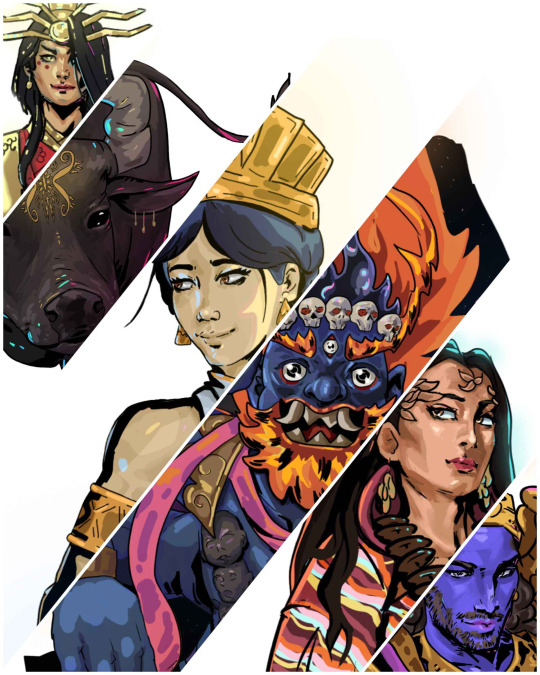
Legendary Figures from Asia in Hades Style.

Lakapati is the Transgender Filipino Goddess of Agriculture, and oversees the nurture of her people. She is prayed to for a bountiful harvest and blesses the crops and livestock. Lakapati displays both masculine and feminine traits and is sometimes depicted as one or the other or fluidly. Her husband is Mapulon the God of Seasons as their union coincides with how seasons and agriculture are importantly tied.
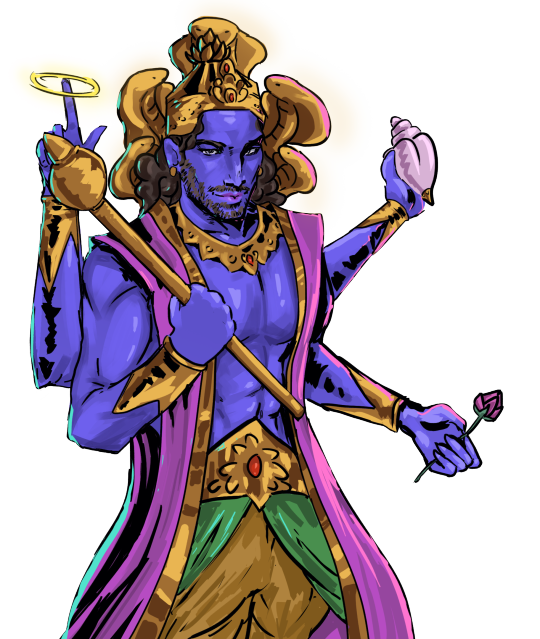
Vishnu is one of the most important deities in Hindu theology. As the God of Time, and the Preserver, he is one of three called the Trimurti along with Shiva the Destroyer, and Brahma the Creator. Like his fellow gods, Vishnu has many avatars including the legendary hero Vamana, and even the Buddha (in some sects of Hinduism).
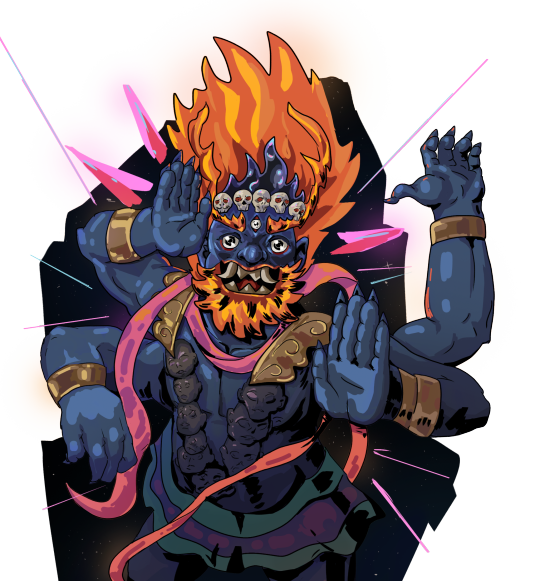
Mahakala is one of the great Dharmapala (Protector of the Dharma) in Tibetan Buddhist Cosmology. His domain is the void, and he maintains command of time and death. He is depicted blue or black as all colors absorbed represent the infinitude of absolute reality (as is all life is absorbed into him in time). As a fearsome deity, he reminds his believers of the wrath that would incur if they were to stray from the Dharma. The five skulls on his crown represent the five Kleshas (negative aspects such as ignorance, selfishness, pride, envy, and depression) that would be transformed into the five wisdoms (knowledge, discipline, observance, equanimity, self-reflection) by his power. His roots tie back to the Hindu god Bhairava (an Avatar of Shiva) and has since become an important figure in many Buddhist Sects. When the universe ends, there will be no Chaos, just the void at the end of time, and there, Mahakala remains.
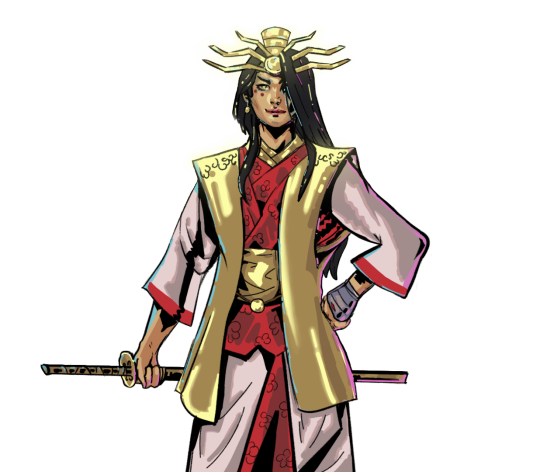
Amaterasu Ōmikami (天照大御神) is the Supreme Deity of the Sun and of Japan. The unbroken line of Imperial Japan was said to begin with the first Emperor, Jimmu said to be descended directly from her. As the Sun Goddess she is in charge of overseeing the heavens and wrangling her numerous siblings including, Tsukuyomi (月読命) the Moon God, Susanoo (スサノヲ) the God of Storms and lesser known Watasumi (海神), the Dragon Spirit of the Sea among many other gods and spirits.
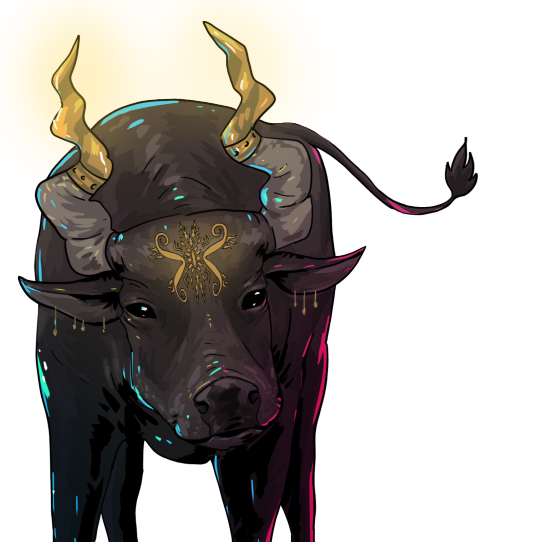
Kting Vor is a Cambodian/Vietnamese Mythological Beast. One distinct feature is its longer, twisting horns. It is called the Snake Eating Cow (or Water Buffalo) because of its unusual diet. Isn't he the cutest...

Âu Cơ is the Goddess who lives upon a legendary snow mountain in Vietnam. She is said to create the first people who lived in what is now the Southern Region of China/Northern Vietnam. She was married to the Dragon Lord Lạc Long Quân. Their union was not everlasting for Âu Cơ longed to return to the mountain and Lord Lạc Long Quân desired to return to his home in the sea. They divided their children in their separation. The ones who followed Âu Cơ populated her mountains and the decedents of the ones who followed Lord Lạc became known as the Hùng Kings.
#hades fanart#hades game#artists on tumblr#hades supergiant#digital art#hades#hades 2#supergiant hades#hades art#oc art
63 notes
·
View notes
Text
Today on my headcanons: are they superstitious?
Note that with superstition I'm primarily talking about belief in/worship of supernatural creatures/practices outside the Gods and known magic. Think knocking on wood/throwing salt over your shoulder/buying fortune slips. However I will make exceptions on beliefs in Gods/Entities that are not explicitly true, like the rumours surrounding some of the Youkai in Inazuma and how to avoid them.
With that being said:
In general, I think out of the regions, Inazuma and Liyue would be the most superstitious, with Mond and Snezhnaya close behind. Yes, Natlan, Fontaine and Sumeru have their own magical creatures and such, but Inazuma, Liyue and Mondstadt have much more obvious displays of superstition- Mond mostly in regards to the Gods (yes including Andriud and Vanessa) and Liyue and Inazuma with their prominent non-human population. Youkai and Adepti seem much more elevated above and less integrated in the general population than Foxians and Elves in Sumeru or Saurians in Natlan/Melusines in Fontaine. Snezhnaya I'm mostly going off of vibes tbh.
Least superstitious I'd say is Khaenri'ah, which is funny given that they're almost entirely based off of/inspired by Germanic Mythology.
I'd say my final order would be Inazuma > Liyue > Snezhnaya/Mond > Natlan > Fontaine > Sumeru > Khaenri'ah
As for the Fatui:
Pierro: Literally from the Atheist nation, so no, and he thinks it's stupid. Unlike a certain someone, though, he keeps his opinion to himself unless asked about it.
Capitano: no, but respects it when others are. Will participate for traditions, or to pay tribute to others culture. Does follow some superstitions just out of habit, but will gladly subvent them If necessary.
Dottore: actively looks at superstitious, tries to figure out how to do them wrong/offend the entity the worst, then does that.
Columbina: ABSOLUTELY superstitious. Technically stronger than most entities, but thinks they traditions are fun, so she follows them. Makes up her own little rumours as well.
Arlecchino: Not really superstitious, but tries her best to follow actual rules that surroung some of Teyvats non human residents, just to be sure. Fontaine is relatively low key in this regard compared to some other reasons, so she mostly doesnt have to worry about it
Crucabena: used to be incredibly superstitious when she was younger, but grew out of it for the most part. Likes using scary fairytales to get the children to do what she says, but lowkey kind of believes some of them herself on a lesser scale.
Pulcinella: yes. The grandpa type of superstitious. Doesn't take it too seriously, but definitely would rather follow the traditions then not.
Scaramouche: Kind of hard to explain. Inazuma definitely seems more suitable for superstition, given the Youkai, but considering his own heritage he's very aware about which legends are true and which aren't, and doesn't feel very threatened by them. Used to follow superstitions out of politeness as Kabukimono, now he doesn't really care. Imitates Dottore in actively disobeying tradition, but only in regard to the Shogun and Yae- he doesn't dislike the youkai enough to try and piss them off on purpose, although he definitely doesn't go out of his way to respect them either. Actually probably has quite a few urban legends and superstitions surrounding himself as Kunikuzushi and the Kabukimono.
Sandrone: no. Doesn't give a fuck. Thinks Dottore's approach is really annoying because he's actively inconveniencing everyone else in the process, but she herself wont follow tradition unless its useful to her.
La Signora: it's a little hard Not zo project on her (and Pierro) given they're from the nations inspired by my culture xD For her, I'd say surprisingly yes. She wont follow Seelies in the dark because they remind her of Will O' Wisps, and definitely believes Dragonspine and Old Mondstadt are haunted. Has shared books on scary Mondstsdtian fairytales (look I need to bring up German fairytales whenever possible) with Crucabena more than once.
Pantalone: Kind of. He used to follow all the good luck superstitions when he was a kid, but have up on them when they werent working.
Childe: a little weird case. Definitely kind of believes in Snezhnayan superstitions (and post Scaramouche leaving he believes in Inazuman ones, because remember the paper mansion?), but likes to take them as a challenge. Will be told to watch out for evil spirits and intentionally try to goad them into fighting him, but doesn't do that around his elders because it's rude and some of them get genuinely scared. Would do 3AM YouTube Challenges.
#genshin impact#not a quote#fatui#fatui harbingers#dottore#columbina#crucabena#pantalone#pierro#childe#scaramouche#la signora#signora#capitano#sandrone#pulcinella#arlecchino
80 notes
·
View notes
Text
Inanna / Ishtar Queer History <3
In my recent masterpost on Inanna, I forgot a major part of her story, and rather than just tack it on as an after thought, I figure I'd make a whole post.
First and foremost, Inanna has always been a feminine goddess, but more than just feminine, she was also seen as the god who could change someone's sex, and wears the armor of a man in most depictions.
Because of this, her cult of followers was predominantly people outside of the binary. She had transgender and "drag" prostitutes working as her priests and priestesses, who often had sex with each other as a ritual to the goddess, regardless of biological sex. Her high priestess would mate with new kings to ensure their fortune, and her other "lesser" priests and priestesses were musicians, singers, and dancers.
Though it is disputed whether or not these prostitutes actually engaged in sex, or if it was symbolic, there were men who started dressing in feminine clothing and using the feminine only dialect, and women assuming the masculine. The "male" would castrate themselves, and were known as Kurgarra, and "female" were known as Galatur. Both were seen as being transformed by the goddess herself, or being created by the god Enki to rescue Inanna from the underworld (see the Descent Of Inanna).
She has always been a young woman, she has never been mythologically depicted as a mother figure or a faithful wife. She has always been true to herself, regardless of how she will be perceived by anyone, especially men.
Despite eventually the ancient civilization succumbing to a patriarchal society, they were not always. Not to say the roles were perfectly equal, or that it was originally a matriarchy, but eventually many female deities turned to male. Inanna managed to withstand this, surviving as the Akkadian Ishtar, the Hittite Suarte, and the Phoenician Astarte. This decline in femininity started with the rule of Hammurabi. Before this, they had significant female deities, and they seemed to have a vast understanding of femininity with the variety of deities, and having one (Inanna) with such a bold personality.
Within her mythology, she is brash, independent, vindictive, impulsive, but also calculating and manipulative. In Inanna and The God of Wisdom, Inanna purposefully goes to Enki with the intention of stealing the Meh, and then purposefully gets him drunk so that he will be compliant, and eventually she becomes Queen. In the Descent of Inanna she has her husband imprisoned in her stead after she finds him with other women when he should've been mourning, and then later decides she misses him, so she forces his sister to take his place for half the year so that she can have him back. Inanna made people want to serve her because of who she was, not what she had to offer, that's why she survived.
She has had multiple lovers throughout mythology, including her husband Dumuzi, but also Sargon of Akkad, and Zababa.
Despite being a highly sexual goddess, her assailant in Inanna and Su-Kale-Tuda is not seen as a lover. In fact, he was regarded as a coward, and her level of consent was never in question. A goddess fell asleep beneath a tree and a human man saw her and assaulted her. And then he hid. He ran away and he hid. And she reigned terror down on the world until she found him and killed him, telling him that he will be forever be remembered as a coward. Not once did anyone say that she was asking for it. Not once did anyone ask what she was wearing. Not once did anyone say that she has sex all the time. It was seen as divine justice for a heinous crime.
#deity devotion#inanna devotee#deity work#deity worship#deity#devotee#goddess inanna#inanna ishtar#inanna#ishtar#mesopotamia#mythology#Mesopotamian mythology#ancient civilizations#witchblr#queer witch#queer history
54 notes
·
View notes
Note
Besides the Illiad and the Odyssey, what other (literature? media? idk) could I read/consume to learn more about Greek mythology/Ancient Greek culture. I use theoi.com to look up specific things, but I want to get into reading the actual sources. Like I see so many excerpts or cool facts people post, and how you incorporate a lot of lesser known Greek mythology things (like your recent fic with Koios), I feel so ignorant in comparison! So please enlighten me!!
(Also I wouldn’t mind if a lot of your recs had Apollo featured in it, he’s my fav!)
heya!!!!
besides the Iliad and odyssey, I highly recommend the Homeric hymns! A lot of the gods are featured in them, especially Apollo! :D also the Theogony and Works and Days by Hesiod! Those four are the foundational texts of Greek mythology and intrinsic to learning about it <3 (I own all four :3 I am still on the Iliad though because I have been busy 😭 rip Alder)
Pseudo Apollodorus’s Bibliotheca is another good read! It compiles the majority of the known mythological world into one book! (I also have this one ;) used it for my Marsyas research :D)
after that, I also suggest Euripedes’s plays, as well as *checks spelling* Aeschylus’s!
Aeschylus’s plays are all compiled into The Oresteia, and Apollo is a prominent figure in it!
But I would also suggest reading Euripedes’s The Trojan Women with it, because Cassandra features in both and I, personally, am a sucker for her and Apollo’s tragedy ✊😔 (I also have the Oresteia hehe!)
Euripides has other good stuff too! Medea is a BANGER of a play from what I hear, and Hecuba, Alcestis, Electra, and all his other works can really help understand Greek culture by reading between the lines :3 (I do not have any of these rip)
there are so many other texts and fragments too, though! But I think these are a good springboard for diving into Greek mythology :3
I also recommend looking into Greek philosophy for understanding Ancient Greek culture. The Delphic Maxims are a good place to start, and I actually reblogged a post here with all of them listed…should be able to search ‘Delphic maxims’ to find it (hopefully, if tumblr isn’t weird).
anywho, this has been your Getting Started With Greek Mythology packet by Alder! :D
#the oracle speaks#asked and answered#anon ask#greek mythology#greek myths#greek myth#ancient greece#tagamemnon#euripides#aeschylus#hesiod#homer#the iliad#the odyssey#the theogony#homeric hymns#greek theatre
55 notes
·
View notes
Note
From the first and foremost to the Twenty-First's post...
I beseech upon thee to give an audience to this needy soul!
If you’re okay with doing another two-in-one, I’d like to know more about The Unnumbered One and The Thirteenth.
Why both of them at once?
…it’s pretty obvious by now.

The Unnumbered, known to none as The Fool, is... an outlier amongst the Arcanas. While known to some as the Arcana of Opportunities, Risks, and Journeys, most mortals have seemingly forgotten about her, or treat her more as a lesser mythological figure than a true deity like the rest.
As a result, The Fool is almost never referred to by her title, and she may be the only Arcana who doesn't really care about being called by name, whether by mortal or Arcana. Also because of this, she's also the Arcana who has spent the most time in the mortal world, having taken multiple forms over the eons of existence.
She adores mortals very much, as she finds their curiosity, tenacity, and determination in life to be very admirable and adorable. Sometimes, she dons forms that let her get VERY close to mortals, even interacting with them directly, a stance that most Arcanas would see as... demeaning or forbidden.
While she does hold a significant amount of respect for the Twenty-First, she doesn't seem to hold the same fear as the others do for them. They treat the Twenty-First like any other Arcana: With a lot of facetiousness, humor, and quirkiness.
Despite the seeming hypocrisy, she herself finds it a bit problematic whenever the other Arcanas get into close contact with the mortals. In her eyes, she has perfected the art of mortal communication, that no disaster or trouble shall befall upon them. So if the others get too close for comfort... she might find a way to get them to either back off and leave, or solve the matter in their own ways.
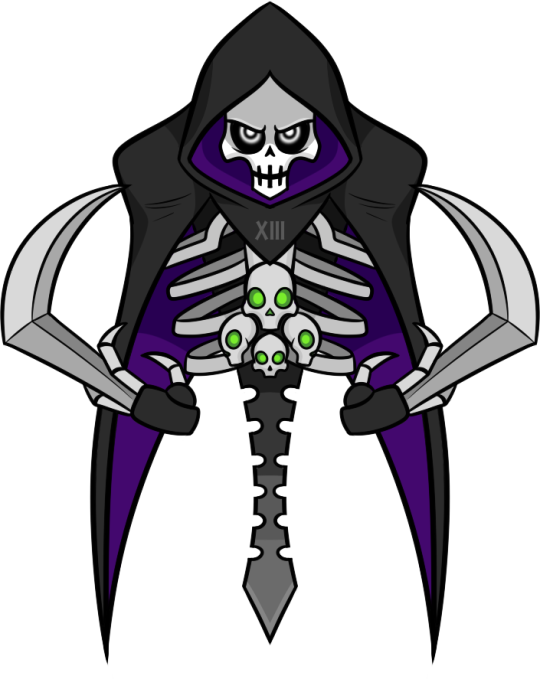
The Thirteenth, known to mortals as simply Death, is the Arcana of Transformation, Transitions, and the End. Despite his name and reputation, the Thirteenth is not necessarily just about the concept of death as in the end of living, but he represents the end of everything, how whenever there is a beginning, there must be an end.
The Thirteenth has been notorious for heralding the end of a reign. According to ancient records, the Thirteenth was said to be present during the fall of the elder kingdoms of the Swords and the Pentacles.
He despises the idea of extending a concept past its "due", lives that live longer than they should, kingdoms that reign for longer than expected. Usually, he is a bystander, acting only when the Tribunal or other Arcana has acted first so he may reap what they had sow. But lately, certain Arcanas have been giving blessings to bunches of mortals that, in his eyes, do not deserve it, and that they interfere with his work and sully the nature of his very existence.
Usually, the Thirteenth never answers prayers, as death is not something you ask for, but rather an inevitability. It arrives when it must, not when you want. ...but when a certain desperate cry calls out from the aether, echoing with need... desperate for change... ...how can he just simply say no?
37 notes
·
View notes
Note
Helloooo I just discovered your Beast Fables worldbuilding and I need to say that it is very impressive, interesting and inspiring !
I've picked up writing recently and one of my story features mythological creature protagonists (only, no humans) so I'm doing à lot or research on chimeras and lesser-known creatures sur as the sak, akhlut or the alphyn (or at least creatures that I didn't know about before doing researches).
The way you share your worldbuilding is short yet efficient, and the illustrations really help ! I especially like your megafauna posts. I've had some troubles defining precisely how to differentiate "animals" from "intelligent creatures", because there are still our known animals but also more. I have questions like "should jackalopes be animals or should they also have a society like griffins or unicorns ?" etc. I also struggle à bit with figuring out biology/evolution. For examples, griffins and hippogriffs are related but still different species. However, opinicus and keythongs would be sub-species of griffins. Etc.
Anyways. I love what you do !!
Thank you so much! I'm glad my work can inspire others!
Well, my best advice is think about the direction of what you want for your fantasy or science fantasy story in question. Does the presence of more or less human-level intelligent characters or societies work for your setting?
For example, in the development of Beast Fables, there was supposed to be "regular" humans, werefolk, and merfolk... but I felt that the entire setting felt more unique when every human is some sort of werefolk, because it opens up a LOT of storytelling opportunities, and helped them turn into a thematic counerpart to the merfolk, who are all based off sea critters.
Based on what you've created for your world so far, and the characters you have set up, think of the lines of "how important it is to establish now?" and "can I save this for later?". That way it helps set up priorities of your worldbuilding and lore.
Now on evolution and biology? Speculative evolution works best, at least in my own opinion, is if it works under the realm of the "plausible". Evolution is after all a series of "good enoughs", and how much of these "good enough" solutions work for whatever niche the creature you have filled. If you can explain well enough why a lifeform adapted this or that, then it should be satisfactory.
BUT, it's always good to research on evolution and natural selection itself to give yourself familiarity on the subject!
#worldbuilding#asks#local-hynena-reblogs#beast fables#speculative evolution#worldbuilding questions#ask
25 notes
·
View notes
Text
ok so i need to talk to yall (facing divine intervention in the bad way if i dont/hj)
so ive recently gotten back into hellenistic paganism because we had a bit of a scare and i just looked up the god of protection in greek mythology and found Soretia, the greek goddess of protection
anyway she set up a pretty casual communication with me and its because im one of her only devotees and ive already sacrificed two apples to her for her protection over where i live and some minor prayers i made
she's a really underappreciated god and i know a lot of people would pray to zeus for protection and i do occasionally thank him, but i also believe that the lesser known gods/goddesses should be known and worshipped more
so if anyone else is starting out with hellnistic paganism and wants someone to pray to for protection from events/people/places/etc. you should make a small shrine with smth similar to a laurel wreath and a few sacrificial apples
her image is also pretty sacred so you wont see it anywhere and will have to figure out how she presents herself to you on your own
sincerely, a Soretia devotee who is using this post as a sacrifice because i dont like eating apples :3
#also yeah i dont really know what to sacrifice but apples and sketches have gotten pretty good reception#also really clear communication im not used to this lmao#uhh so yeah go do some research on soretia and some other minor deities while you're at it#itd make her very happy to offer her services of protection in return for an apple or two#hellenistic#hellenic paganism#hellenic deities#hellenism#hellenic devotion#greek myhtology#greek myth#greek gods#paganism#paganblr#pagan#deity work#thats all the tags i can think of
22 notes
·
View notes
Text
PERSEPHONE



WHO IS SHE?
Persephone, also known as Kore (meaning "young woman” or “maiden" in Greek), is one of the main deities from Greek mythology. She is the daughter of Zeus and Demeter, the goddess of the Harvest. She is also the wife of Hades, the god of the Underworld, and she is associated with spring, fertility, and rebirth.
BASIC INFO:
Appearance: Persephone is typically depicted as a young and beautiful woman, with long, dark hair and eyes. She is often shown wearing a white dress or robe, and she is usually associated with flowers, especially flowering plants that bloom in the spring. She is also often associated with pomegranates, which symbolized her wedding to Hades, and which she ate while she was in the Underworld.
Personality: Persephone is usually depicted as kind, gentle, and compassionate. She is often seen as a mediator and peacemaker, and a defender of the innocent and vulnerable. She is also often portrayed as a motherly figure who is caring and nurturing. She is also sometimes seen as defiant and rebellious, and she is known to have a more powerful side that can punish those who defy her.
Symbols: pomegranate, waxing moon, narcissus, bones, seeds of grain, bats, torch, flowers, and deer
Goddess of: spring, the dead, the Underworld, grain, and nature
Culture: Greek
Plants: asphodel wheat, willow, narcissus, lily, ivy, cherry tree, lily of the valley, daisy, lavender, vines, roses, pomegranates, oak, and hibiscus
Crystals: rose quartz, pigeon’s blood, rosolite, star diopside, flower agate, grossular, balas ruby, chiavennite, red spinel, clinoptilolite, Mozambique garnet, heliodor, African jade, uvarovite garnet, biotite, green calcite, hiddenite, green agate, African emerald, quantum, vivianite, indigo gabbro, green jasper, diopside, garnet, clinochlore, aventurine, iolite, and snowflake obsidian
Animals: deer, bat, black ram, parrot, and monkey
Incense: rose, pomegranate, jasmine, apple, vanilla, almond, horal, bergamot, and cinnamon
Practices: death magick, ancestor worship, spirit work, growth, transformation, embodying the divine feminine, balance, and plant/earth magick
Colours: green, pink, black, light blue, purple, magenta, indigo, and yellow
Numbers: 3, 6, and 7
Zodiac: Virgo
Tarot: High Priestess and Ace of Pentacles
Planets: Earth and Pluto
Days: Monday, Friday, Ostara, Beltane, Lammas, Samhain, Lesser Mysteries. Eleusinian Mysteries, Proerosia, Stenia. Thesmophoria, and Heliogenna
Parents: Zeus and Demeter
Siblings: several paternal half-siblings and maternal half-siblings
Partner: Hades
Children: Melinoë, Zagreus, and Erinyes
MISC:
• Grains: due to her connection to the cycle of life and death. She is often depicted with grains, such as wheat, barley, and oats, which symbolize the cycle of life and death.These grains represent the cycle of life, as they are sown and then harvested, only to be sown again in a constant cycle. This symbolic representation of death and rebirth aligns perfectly with Persephone's association with the underworld and the cycle of seasons. Therefore, she is associated with grains to showcase the cycle of life and death.
• Spring: due to her connection to the changing of seasons and rebirth, she is often depicted as rising from the afterlife in spring, representing the renewal and rebirth of nature.This is because in the Greek myth, Persephone spends part of the year in the underworld with Hades, but returns to the land of the living in spring. Her return symbolizes the return of light and warmth, and the blossoming of nature.Therefore, she is associated with the season of spring as she symbolizes the rebirth and rejuvenation that comes with the new season.
• Pomegranates: according to the myth, Hades abducted Persephone and took her to the Underworld, where he forced her to eat a pomegranate. This act was a symbolic gesture of his hold over her, and it was also seen to symbolically represent her connection to the Underworld.The pomegranate became closely associated with Persephone and the Underworld, and it has remained a symbol of Persephone and her association with the Underworld ever since.
• Flowers: she is associated with flowers due to her association with spring. She is often depicted holding a bouquet of flowers, or being surrounded by blooming flowers.This is especially the case from the Greek festival of Anthesteria, which was a celebration in honour of Persephone's return from the Underworld. During this festival, people would decorate their homes and temples with flowers, representing the growth and renewal associated with Persephone's return.
• Birds: mainly doves, she is frequently depicted with a dove on her shoulder, and she overall shown with doves all around her.There are a couple of reasons for this. First, doves have long been symbolic of peace and tranquility, which aligns with Persephone's gentle and calming nature. Second, doves are often associated with symbols of fertility and rebirth, which aligns with Persephone's connection to the Underworld and spring.
• Water: she is associated with water for a couple of reasons. First, she is the Goddess of spring, and water is a vital factor for life and growth. Water is necessary for flowering bloom and green plants, so it is closely associated with the growth and renewal associated with spring. Second, water is also a symbol of rebirth and renewal, as it is a fluid element that is constantly changing and transforming. This fits well with Persephone's role as an Underworld Goddess and her connection with the cycle of life and death, as death and rebirth are represented as a transformation process.
• Gold: the Underworld is associated with riches and treasures that are commonly represented in the form of gold. This connection to riches represents the fact that the Underworld was a place of great wealth and abundance, and it represents the treasures that were found there, such as gold, jewels, and precious metals. This is another aspect of Persephone's connection to the Underworld and her role as a divinity of death and rebirth.
• Trees: they represent the natural cycle of life and death, as they grow and flourish during the warm months, then shed their leaves during the winter months, before starting the cycle all over again.Trees are also associated with fertility and rebirth, as they produce seeds and fruit that propagate new life. This ties in with Persephone's role as a Goddess of spring, and her connection with the Underworld and the cycles of nature.
FACTS ABOUT PERSEPHONE:
• She takes her role in the Underworld seriously.
• Her epithets included but were not limited to: Despoina (The Mistress), Melindia (Honey), Aristi Cthonia (Best Cthonic), and Kore (The Maiden).
• Unlike Hera and Amphitrite, Persephone didn’t have a husband that constantly cheated on her (she was married to Hades). However, there is a myth about her cheating on Hades with Adonis, depending on the version. As far as I know, Hades did nothing about the matter. I think that implies it didn’t count as cheating to him, or maybe Persephone only loved Adonis as her son, which makes sense to me since she raised him. But yes, it’s perfectly acceptable and legitimate to say she cheated on Hades.
• Persephone is often called a spring or vegetation goddess but all that seems to mainly be related to Demeter, her mother, when it’s time for Persephone to return her. Truly incidental. Persephone was much more an Underworld goddess than a flowery Goddess.
• There’s evidence to suggest that, as far as religious history goes, Persephone as a character in religion is older than Hades, and was an underworld deity too.
• Some sources suggest Persephone was the mother of Dionysus, but to be fair Dionysus has a bajillion origin stories.
• As far as I know, and correct me if I’m wrong, it wasn’t too popular to depict Persephone with red hair colours until the Victorian era, when a popular red-headed model was used for a famous painting of Proserpina (the Roman equivalent to Persephone). Before, she had occasionally been depicted with red hair, but black and blonde were just as popular. Nowadays, in media, she’s often portrayed as red or pink haired, although even that trend is dying again.
• Some people like to think Persephone was a minor or weak goddess. That was simply not true. She was considered frightening in her own right.
• Someone tried to kidnap her right from the Underworld. Hades had him attached to a chair for eternity.
HOW TO INVOKE PERSEPHONE:
First, set up an altar or sacred space dedicated to her, you can then set offerings such as candles, flowers, and other symbolic items are also essential to respectfully honouring her. Prayers and incantations can be said to her to ask for guidance, support, and her blessings. Meditation and visualization can be used to feel Persephone's presence and connect with her energy. Feast days and holidays can also be celebrated to honour her.
PRAYER FOR PERSEPHONE:
Queen Persephone, goddess of the Underworld. I come before you in humility, I seek to find peace and healing to shed myself of pain and strife. I ask for your guidance and strength in my time of need to weather through the storms of life.
Thank you for your love and kindness. Please open my path to the light and give me the strength to continue to walk down this path. May we all find peace and healing, in the realm of both life and death. Hail Queen Persephone.
SIGNS THAT PERSEPHONE IS CALLING YOU:
• A sense of calmness or peace around you.
• Feeling connected to nature and the changing of seasons.
• Attracting more birds or other doves.
• Seeing or smelling flowers in unexpected places.
• Having vivid dreams about death and rebirth.
• Experiencing a sudden increase in energy and motivation.
• Feeling connected to the Underworld and the realm of death.
• Having a deep feeling of contentment and acceptance within yourself.
OFFERINGS:
• Pomegranates/pomegranate juice.
• Honey.
• Floral tea.
• Breads.
• Flower crowns or arrangements.
• Dark chocolate.
• Flowers.
• Crushed mint.
• Animal bones.
• Jewelry.
• Art of bats, rams, or deer.
• Crystals: rose quartz, agate, black onyx, pink tourmaline, obsidian, coral, and jasper.
• Spring water.
• Grains.
• Plants.
• Incense: vanilla, almond, horal, bergamot, and pomegranate
• Sweets.
• Dirt from a dead plant (or person).
• Wine.
• Seeds.
DEVOTIONAL ACTS:
• Stop to smell flowers.
• Pair lace and leather together, she loves this.
• Singing.
• Plant flowers.
• Wear pomegranate scented things--perfume, lotion, lip gloss, etc.
• Tend to wild plants if they need care.
• Go barefoot more often and feel the way the ground feels on your bare feet.
• Honour the dead.
• Support local farmers and beekeepers.
• Honour the deaths of animals and if you can, bury them or leave them in a place where nature will care for them.
• Buy yourself a nice bouquet of flowers, or make your own.
• Place flowers on barren graves.
• Spread seeds of native flowers on the sides of highways or other unincorporated places (be sure to check local laws on this).
• Wear something fancy when you feel like it, make yourself feel like the royalty you are.
• Offer her fruits/nuts.
• Listen to music that reminds you of her.
• Wear a flower crown.
• Collect crystals like rose quartz, garnet, citrine, green tourmaline, and topaz.
• Rose quartz is a go-to stone for me for many Gods, Persephone being one of the many.
• She really digs topaz and the tourmaline in my experience.
• Love yourself, of course, just as she loves you.
• Gardening.
• Taking care of graveyards.
• Visiting forests and fields.
• Learn about local plants, flowers, and herbs.
• Creating flower crowns.
• Going bone hunting.
• Creating a more biodiverse lawn/backyard.
• Not killing animals (spiders, mice, etc.)
#fyp#fypシ#fypシ゚viral#fypage#fyppage#tumblr fyp#satanism#satanist#deity#deity work#deity worship#occult#persephone#greek mythology#goddess#spring#underworld#nature#grains#hades and persephone#information#masterlist#themortuarywitch
79 notes
·
View notes
Photo

4 Elizabethan Playwrights and Poets
The Elizabethan era is often regarded as a golden age for English culture, language, and literature. Though William Shakespeare, Christopher Marlowe, Ben Jonson, and Edmund Spenser are amongst the best remembered writers of this era, many other poets, playwrights, and dramatists helped to forge this literary golden age. This article examines four lesser-known Elizabethan playwrights and poets.
John Lyly
Amongst the first of the great Elizabethan dramatists was John Lyly (c. 1553/54-1606), whose popularity reached its peak in the days before Shakespeare and Marlowe. Born in Kent, England, in either 1553 or 1554, he graduated from both Oxford and Cambridge, earning him a place amongst the group of well-educated late 16th-century English poets referred to by literary scholars as the 'University Wits'. Lyly was not a particularly gifted student – indeed, the antiquarian Anthony Wood notes that his genius was "naturally bent to the pleasant paths of poetry" rather than those of academics. Shortly after leaving Oxford, Lyly finished his first work, a prose romance entitled Euphues: The Anatomy of Wit (1578). It was an instant bestseller, undergoing four editions within its first year, and was quickly followed by a second part, Euphues and His England (1580).
These works were, according to scholar Stanley Wells, "short on narrative, but rich in dialogue, argument, and debate" and had a "colossal, if brief, impact on the development of English prose" (63). Here, Wells refers to the prose style with which Lyly writes, called 'euphuism', which involves an "unremitting use of alliteration, antitheses, puns, carefully balanced clauses, similes derived from natural history, and many other rhetorical figures of speech" (Wells, 64). This kind of writing was lighter and more elegant than Elizabethan audiences were used to reading and quickly became fashionable, later influencing the works of Robert Greene and Shakespeare.
After his almost overnight success, Lyly turned to writing comedies. With the patronage of Edward de Vere, 17th Earl of Oxford – a poem-loving aristocrat sometimes thought to be the true author behind Shakespeare's works – Lyly leased the first Blackfriars Playhouse in 1583. His first two plays, Campaspe and Sapho and Phao, were performed here the following year by the Children of Paul's, a troupe of boy actors favored by Elizabeth I of England. Throughout the 1580s and '90s, Lyly would continue to write plays – the most significant of these is his 1588 comedy Endymion, which was written in his trademark euphuistic style and contains multiple references to ancient myths and traditional English folklore. Indeed, all of Lyly's plays are characterized by mythological references as well as light and witty dialogue, leading him to be considered the first of the Elizabethan playwrights to write in "plain English". His style influenced the next batch of playwrights who would quickly eclipse him in fame; by the late 1580s, writers like Christopher Marlowe and Thomas Kyd had taken Lyly's place in Elizabethan theatre. As his influence faded, Lyly focused less on playwrighting and more on his political career. Having sporadically sat in Parliament since 1580, he now coveted the position of Master of the Revels, an office that was continually denied to him. Frustrated, he wrote the queen a despairing letter in 1593, begging her to remember his years of service:
Thirteen years your Highness' servant, and yet nothing; twenty friends that though they say will be sure, I find them sure to be slow; a thousand hopes, but all nothing; a hundred promises, but yet nothing. Thus casting up the inventory of my friends, hopes, promises, and time the summa totalis amounteth in all to just nothing.
(Wells, 66)
Lyly died in 1606, never having achieved his dream of becoming Master of the Revels. Like many of his contemporaries, his memory rests within Shakespeare's long shadow, although his influence looms large in the Bard of Avon's work; indeed, Shakespeare's plays Twelfth Night and Much Ado About Nothing are stylistically similar to Lyly's work, a fact that would have been recognized and appreciated by Elizabethan audiences. One example of Lyly's poetry is Oh, For a Bowl of Fat Canary:
Oh, for a bowl of fat Canary,
Rich Palermo, sparkling Sherry,
Some nectar else, from Juno's dairy;
Oh, these draughts would make us merry!
Oh, for a wench (I deal in faces,
And in other daintier things);
Tickled am I with her embraces,
Fine dancing in such fairy rings.
Oh, for a plump fat leg of mutton,
Veal, lamb, capon, pig, and coney;
None is happy but a glutton,
None an ass but who wants money.
Wines indeed and girls are good,
But brave victuals feast the blood;
For wenches, wine, and lusty cheer,
Jove would leap down to surfeit here.
Read More
⇒ 4 Elizabethan Playwrights and Poets
#History#ElizabethanTheatre#BabingtonPlot#ChidiockTichborne#ElizabethanAge#GeorgePeele#JohnLyly#RobertGreene#WilliamShakespeare#WHE
39 notes
·
View notes
Text
"Nine-headed hermit": the early history of Zhong Kui (and his sister)

Gong Kai's painting Zhongshan Going on Excursion, showing Zhong Kui, his sister and various demons during a journey (wikimedia commons) Zhong Kui is probably one of the most recognizable figures from Chinese mythology today and continues to star in novels, movies and other works. However, his modern image largely depends on sources the Ming and Qing periods. In this article, I’ll attempt to instead shed some light on some lesser known aspects of his earlier history. You will be able to learn why he was called a “nine headed hermit” despite having only one head, what he had to do with foxes, when his sister was portrayed as an exorcist like him, and more. As a bonus, I’ve included a brief summary of Zhong Kui’s reception in medieval Japan.
The earliest history of Zhong Kui
Zhong Kui’s history goes all the way back to the Zhou period (most of the first millennium BCE). A homophone of his name (鍾馗), zhongkui (終葵; also zhongzui, 終椎) at the time referred to a type of ritual mallet used to expel demons. During the Six Dynasties period first cases of this term (now written as 鍾馗 ori 鍾葵) being used as a personal name start to pop up. The purpose was most likely to confer the protection granted by such objects to a child just through their name. Numerous cases are attested, and it doesn’t seem the bearers of the moniker Zhong Kui can be distinguished by a specific origin, social class or even gender. The earliest possible reference to a specific supernatural being named Zhong Kui comes from the Taishang Dongyuan Shenzhou Jing (太上洞淵神咒經; “Scripture of the Divine Incantations of the Abyssal Caverns of the Most High”), a Daoist work possibly composed as early as in the fourth century. The oldest surviving copy of the passage concerning Zhong Kui has been identified in a copy from Dunhuang dated to 664. He appears in it as an assistant of king Wu of Zhou and Confucius (sic) who helps them subjugate ghosts and disease demons. It is not impossible that to the compilers of Taishang Dongyuan Shenzhou Jing Zhong Kui was only a stand-in for an exorcist, though, not a single well defined figure. There’s an eyewitness account of such specialists dressing up in leopard skins, painting their faces red and announcing they are Zhong Kui in another, slightly newer Dunhuang text. It specifies that many Zhong Kui exist, and that they answer to the “General of Five Paths”, an originally apocryphal Buddhist figure eventually canonized as one of the kings of hell (you can find an excellent article about him here). In any case, regardless of the clear evidence for ambiguous use of the term in earlier times, it is agreed Zhong Kui became a well defined figure by the end of the Tang period. That’s also when legends about his origin started to circulate.
The legend of Zhong Kui

A typical depiction of Zhong Kui as a Tang period official by the Qing period artist Lü Xue (wikimedia commons)
According to the most popular version of Zhong Kui’s origin story, he was a scholar from the Zhongnan Mountains who lived during the reign of Gaozu of Tang (reigned 618-626). He took part either in the imperial examination or the imperial military examination (that’s an ahistorical detail - it was established by Wu Zetian in 702), but failed. This detail is not elaborated upon further in early accounts, but by the Ming period it was attributed not to lack of skill but rather to prejudice against Zhong Kui’s physical appearance (he is fairly consistently described as dark-skinned, unusually tall, with a bulbous head and excessive facial hair). It’s possible that this new backstory was based in part on experiences of real officials of foreign origin, whose appearance was sometimes mocked by their peers, as already documented in Tang sources. Another possibility is that the descriptions were meant to be exaggerated to the point of making him resemble a demon, though. Either way, out of despair caused by failure Zjong Kui committed suicide by smashing his head against the steps leading to the imperial palace. However, since in his final words he swore to protect the emperor and his realm, he didn’t return as a vengeful ghost, but rather as a queller of malevolent supernatural entities. Alternatively, he took this role out of gratitude for Gaozu, who was saddened by his death and organized the burial worthy of an honored official for him. Note that in later plays which often serve as the basis for modern adaptations, the burial is typically arranged by a certain Du Ping (杜平), a friend of Zhong Kui from back home. Apparently a version in which the kings of hell are so impressed by Zhong Kui that they decide to make him the king of the ghosts also exists, though I was unable to track down its original source. In any case, he is associated with Mount Fengdu - one of the terms referring to the realm of the dead - in a poem by Song Wu (宋无; 1260–1340) already. He, or at least generic clerk figures based on his iconography, also sometimes appear in Song period paintings of the Ten Kings.
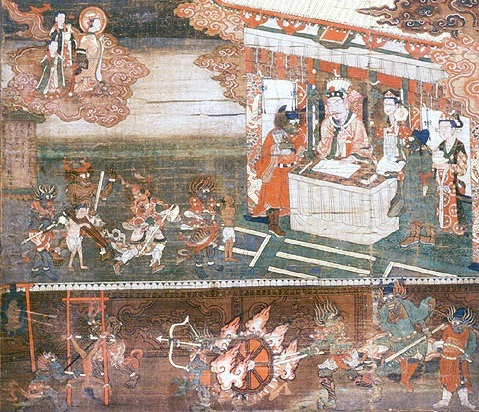
Several Zhong Kui-like clerks from a depiction of hell in Sermon on Mani's Teaching of Salvation (wikimedia commons)
According to Shih-shan Huang a single example of such a figure has even been identified in a Manichaean context, specifically in the scroll Sermon on Mani’s Teaching on Salvation.
Manichaean curiosities aside, supposedly the first person to be aided by Zhong Kui was emperor Xuanzong of Tang. At some point he fell gravely ill. In a dream, he saw a demon who attempted to steal a flute which was one of his most prized possessions. However, the attempt was foiled by a fearsome giant, who dealt with the thief rather brutally, poking out one of his eyes and then devouring him. After completing this act of demon quelling, he explained that he is Zhong Kui, and how he came to fulfill his current role. After waking up, Xuanzong felt healthy again. He was so impressed he commissioned Wu Daozi, arguably the most famous artist in China at the time, to prepare a painting of Zhong Kui which could be used as a talisman against any further supernatural issues. Supposedly it left quite the impression on the general populace, and soon numerous images of Zhong Kui started to be distributed as talismans. There is definitely a kernel of truth to this part of the legend, as eyewitness accounts of Wu Daozi’s painting exist, but the work itself is lost. As a side note, it’s worth pointing out the flute thief demon, despite meeting a gruesome end here, enjoyed a literary afterlife of his own. A certain Li Mingfeng (李鳴鳳), the author of a colophon on one of the earliest surviving Zhong Kui paintings, suggests that the (in)famous rebel An Lushan might have been a reincarnation of this specific entity. While I am not aware of any other attempts at providing him with a backstory, in Ming period retellings of the legend, he received a name, Xu Hao (虛耗).
Zhong Kui’s later career
Zhong Kui’s popularity grew after the Tang period, and he arguably eclipsed figures such as the fangxiang (方相) or the baize (白沢) as the demon queller par excellence. Legends about his origin and his first notable act of demon quelling which I summarized above spread far and wide during the reign of the Song dynasty. After becoming a well defined figure, Zhong Kui came to be most commonly classified as a ghost (鬼; gui). In texts from the Song and Yuan periods he is often labeled more specifically as a “big ghost” (大鬼, dagui) or “ghost hero” (鬼雄, guixiong). However, his popularity effectively made him a god in popular imagination, and as a matter of fact he is referred to as such. His divinity is not exactly conventional, though. This topic is addressed in Fu Lu Shou Xianguan Qinghui 福祿壽仙官慶會 (The Immortal Officials of Happiness, Wealth and Longevity Gather in Celebration) by the Ming playwright Zhu Youdun (朱有燉; 1379-1435). Zhong Kui says himself that unlike his peers, he has no festival to call his own, and receives no regular offerings - and yet, he still vanquishes malicious entities on behalf of humans as long as talismans showing him continue to be distributed.
Interestingly, despite his long career in texts, no images of Zhong Kui older than the thirteenth century are known. This is mostly a matter of selective preservation, though - we know that depictions of him existed as early as in the ninth century, and that they were mass produced, presumably as woodblock prints, in the tenth. However, he didn’t necessarily look similar to his modern depictions. He actually only came to be depicted as a Tang scholar in the Song period. It seems earlier his costume might have varied. One thing which seemingly remained consistent when it comes to Zhong Kui’s appearance is his facial hair. This feature is even emphasized in many of his epithets, such as “Old Beard” (老髯, Lao Ran), “Bearded Elder” (髯翁, Ran Wong) or “Bearded Lord” (髯君, Ran Jun). It’s possible that this was initially a way to highlight his vitality and his opposition to disease-causing demons. Tang and Song sources indicate the state of facial hair could be viewed as an indicator of health. There’s even a handful of peculiar anecdotes about certain emperors, like Taizong of Tang or Renzong of Song, believing their facial hair has supernatural healing powers and offering ailing courtiers concoctions in which it was one of the ingredients. There’s no evidence Zhong Kui’s hair was ever believed to serve a similar purpose, though. Not all of Zhong Kui’s titles revolve around his beard, though. An interesting example is “Nine-Headed Hermit” (九首山人). The intent isn’t to imply he has nine heads, it’s a multilayered pun instead. The character 馗 in Zhong Kui’s name is a combination of 九, “nine”, and 首, “head”. Referring to him as a “hermit”, literally “man of the mountain”, is likely supposed to show that he traverses areas traditionally believed to be inhabited by demons.

The nine-headed snake Xiangliu (wikimedia commons)
Chun-Yi Tsai suggests that this title also highlights Zhong Kui’s physical prowess by implicitly evoking “a nine-headed serpent known for its tremendous strength in Guideways through Mountains and Seas” (presumably Xiangliu).
Zhong Kui’s strength lets him punish his enemies in various unexpectedly creative ways. The earliest sources already mention he could grind vanquished demons in a mill, for instance. References to eating them are particularly common. Depending on the source, Zhong Kui might simply devour them whole, hunt and prepare them like game animals, chop them up to pickle them, mince them to prepare meat snacks, squeeze them to make juice and wine, and so on. Such comedically gruesome descriptions are generally limited to textual sources, since violence was rarely depicted in other mediums, even in relation to military topics. Wu Daozi’s lost painting was apparently one of the exceptions, as according to a tenth century description it showed Zhong Kui gouging out the eyes of the captured demon.
Zhong Kui’s sister and other assistants
While Zhong Kui is often depicted in the company of nondescript demons, there are relatively few recurring figures associated with him. The main exception is his sister. The Song period painter Gong Kai (龔開) and his contemporary Li Mingfeng (李鳴鳳) simply refer to her as Amei (阿妹), literally “younger sister”, though here it’s apparently a personal name, following Chun-yi Tsai’s interpretation. Her origin is unknown, and she is not present in any of the early variants of the legend.
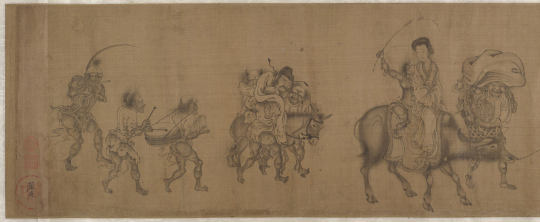
Zhong Kui Marrying Off His Sister (wikimedia commons)
Today Zhong Kui’s sister is known chiefly from works of art in various mediums which can be broadly subsumed under the label “Zhong Kui marrying off his sister” (鍾馗嫁妹, Zhong Kui jiamei) which proliferated through the Ming and Qing periods. This label is sometimes applied to earlier paintings too, for example Zhong Kui Marrying Off His Sister (鍾馗嫁妹圖, Zhong Kui jiamei tu) is the conventional modern title of a scroll attributed to the poorly known painter Yan Geng (顏庚). A colophon from the Ming period describing this work calls the figure presumed to be Zhong Kui’s sister Ayi (阿姨; an informal way to refer a maternal aunt) as opposed to Amei. Chun-yi Tsai states it is not impossible that the woman is supposed to be Zhong Kui’s wife, rather than his sister, though. The painting can be dated to the Yuan period, and there is no evidence for the story of Zhong Kui marrying off his sister before the Ming plays - granted, it is not impossible that it was already in circulation earlier. Still, other paintings showing Zhong Kui marrying off his sister only date to the Qing period. Additionally, the procession might be a parody of paintings showing rural marriages or couples moving to a new house.
While as far as I am aware this eventually went out of fashion, in early sources Zhong Kui’s sister could be portrayed as an exorcist herself. An example can be found in one of the sermons of the Chan monk Yuanwu (圓悟; 1063–1135), in which he states that celebrations on the “Double Fifth” (端午節, duanwu jie) - the fifth day of the fifth month - involved a dance of “Zhong Kui and his little sister”. A reference to performers dressed up as the pair (as well as kings of hell, gods of soil and stove, various warrior deities and more) has alsobeen identified in an account of celebrations in Kaifeng from the end of the reign of the Northern Song dynasty.
Similar evidence can be found in art too. For example, Zheng Yuanyou (鄭元祐; 1292-1364) in a poem inspired by a painting titled Zhong Kui’s Sister (馗妹圖; as far as I am aware, this work has not been identified) states that she travels alongside her brother, that she’s armed with a sword, and that demons fear her. A related portrayal of her is known from a critical review of the works of Si Yizhen (姒頤真), a Song dynasty painter. According to Gong Kai, in one of his paintings she is shown in tattered (or unbuttoned - the term used, 披襟, can mean both) clothes, and chases away a boar attacking her brother. He was evidently not fond of this innovation, and criticizes it as “vulgar” and inappropriate. It needs to be stressed that Gong Kai’s displeasure wasn’t necessarily tied to presenting Zhong Kui’s sister as a demon queller, though. In fact, he is actually the author of the most famous work portraying her in this role.
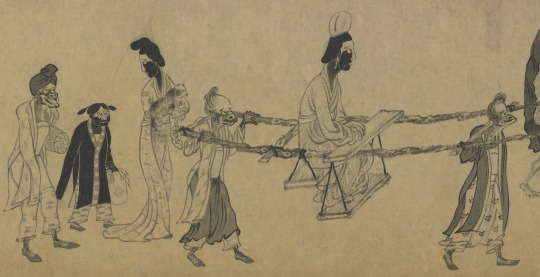
Gong Kai's take on Zhong Kui's sister and her attendants (wikimedia commons; cropped for the ease of viewing)
Gong Kai depicted Amei in unusual black makeup, which is also worn by female demons accompanying her (note the one carrying a kitty!). This might be a parody of the sanbai (三白; “three whites”) face painting popular in the Song period. She and her attendants wear robes decorated with depictions of the “five poisons” (五毒), a term referring to animals perceived as particularly dangerous and inauspicious. The exact list varies, though centipedes, scorpions and snakes in particular are mainstays. The five poisons are directly associated with Zhong Kui, as he can be invoked to ward them off. Direct evidence first appears in the Qing period in accounts of the well known Dragon Boat Festival, but it’s not impossible this was an earlier development.
It is presumed that Gong Kai’s painting might depict Zhong Kui and Amei looking for a demonic version of Yang Guifei, as indicated by various hints in colophons. Her portrayals in art are quite diverse, but attributing demonic traits to her would be hardly unparalleled - she could even be described as a “palace demon” (宮妖, gong yao). The decline of the Tang dynasty was blamed on her, and metaphorically she might have been invoked to criticize other people believed to improperly use the power granted to them by the imperial court.
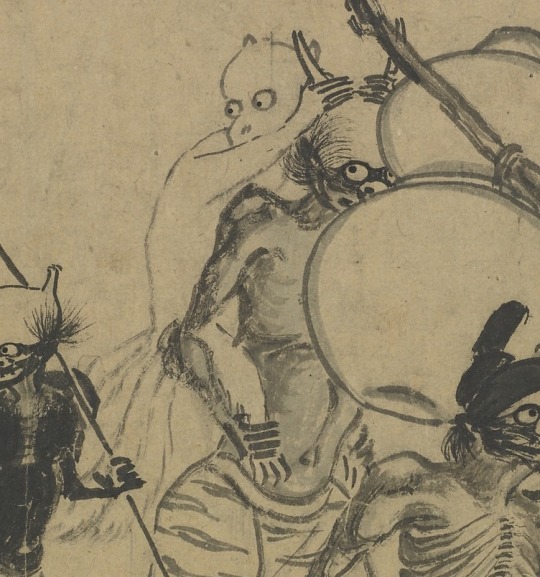
Gong Kai’s painting also depicts a less recurring member of Zhong Kui’s entourage. One of the demons carries a fox, specifically a nine-tailed specimen. The association between this animal and Zhong Kui goes all the way back to the early Tang period. In one of the Dunhuang manuscripts, the demon queller’s entourage includes a nine-tailed fox and a baize, who acted as bringers of good luck alongside him. It’s also worth pointing out that in another text from the same site, his mount during the hunt for a wangliang (魍魎; I will likely cover this entity a future article, stay tuned) is a “wild fox”. Chun-Yi Tsai attributes the inclusion of a nine-tailed fox among Zhong Kui’s servants as a “family pet” of sorts to the portrayals of this supernatural creature both as an apotropaic antidote to poison (including the five poisons) and as a demon in its own right. It would be a suitable member of Zhong Kui’s entourage both as a conquered malevolent being and as an amplifier for his exorcistic, protective power. A further possibility is that the association is the result of wordplay. A new year celebration involving a procession of people dressed up as members of Zhong Kui’s entourage, including his sister and various supernatural attendants, was known as dayehu (打夜胡). The homphony between 胡 and 狐, “fox”, might have resulted in the inclusion of the animal among the helpers.
Post scriptum: Zhong Kui in Japan
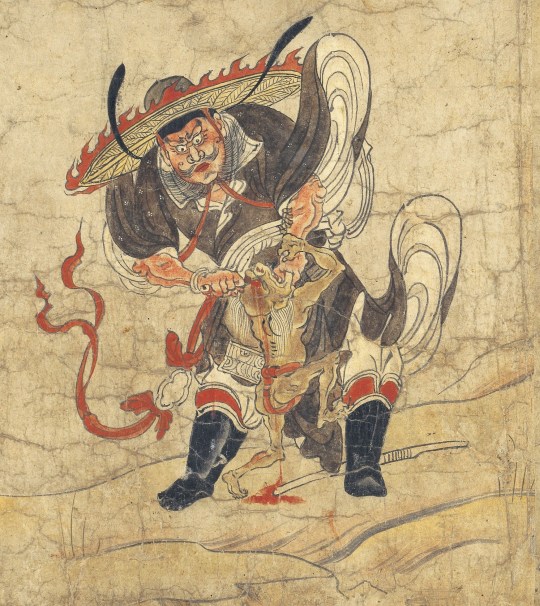
Zhong Kui, as depicted in Extermination of Evil (wikimedia commons)
Zhong Kui - or rather Shōki, following the Japanese reading of his name - probably reached Japan in the Insei period. Many other figures originating in China reached a considerable degree of popularity in Japan at roughly the same time - Taishan Fujun, Siming, Wudao Dashen, Pangu, Shennong, the examples keep piling up.
The oldest known Japanese depiction of Zhong Kui, which you can see above, is a painting from the twelfth century set known as Extermination of Evil. It might look a bit outlandish compared to most of the other depictions shown through this article, but I was able to locate a very close Chinese parallel:
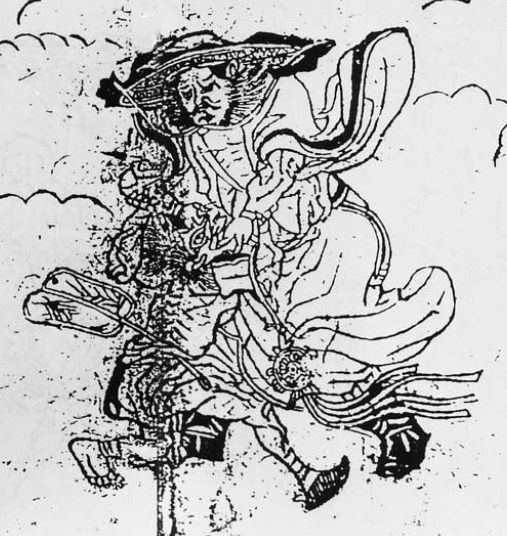
A Yuan period depiction of Zhong Kui from the collection of the Beijing Library, via Richard von Glahn’s Sinister Way. Reproduced here for educational purposes only.
This is a Yuan period illustration said to be based on Wu Daozi’s painting. Zhong Kui doesn’t look like a Tang scholar yet, and the jacket and wide-brimmed hat are remarkably similar. It seems safe to assume that the Japanese painter was following a similar model - presumably one of the many now lost early depictions of Zhong Kui. Slightly antiquated iconography surviving far away from the core area associated with a specific figure would hardly be unparalleled - it has been recently suggested that the baize/hakutaku is a similar case, with Japanese depictions and descriptions matching Tang sources fairly closely, but missing the elements which developed in the Song period or later. For the most part, Zhong Kui fulfilled a similar role in Japan as in China: he was regarded as a fearsome demon queller, and images representing him were distributed for apotropaic purposes. However, it’s also important to note that there were certain innovations. He arrived in Japan at the brink of the middle ages - theologically speaking an era of unparalleled innovation, during which both native and imported figures were interpreted in unexpected ways, leading to the rise of a new “medieval mythology”. Zhong Kui was hardly an exception from this trend. A “medieval myth” involving Zhong Kui is known from Hoki Naiden (ほき内伝; “Inner Tradition of the Square and the Round Offering Vessels”), an onmyōdō treatise traditionally attributed to Abe no Seimei, but most likely written by one of his descendants in the fourteenth century. Curiously, Zhong Kui’s name is written in it as 商貴 instead of the expected 鍾馗.
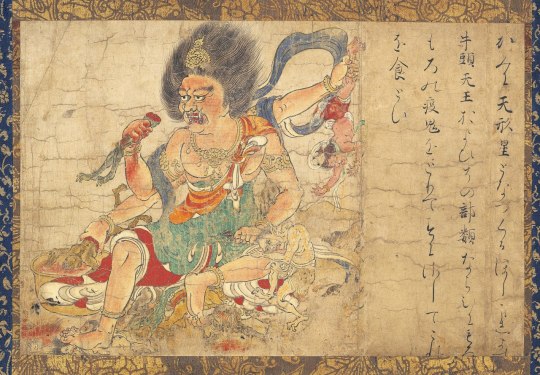
Tenkeisei (wikimedia commons)
In the Hoki Naiden, Zhong Kui is still a queller of malevolent supernatural beings. However, instead of being a scorned scholar, he is a yaksha who became the ruler of Rājagṛha, a city in India. He is said to correspond to both the medieval Japanese deity Gozu Tennō (牛頭天王), and to his celestial “double” Tenkeisei (天刑星; from Chinese Tianxingxing), the “star of heavenly punishment” (I covered him here). They are said to be his manifestations respectively on earth and in heaven. This equation might seem random at first glance, but both of them actually had a lot in common with Zhong Kui: all three were believed to keep demons, especially those causing diseases, in check. Curiously, the reinterpretation of Zhong Kui as a yaksha turned king can also be found in the Genkō Shakusho (元亨釈書), a Kamakura period Buddhist history book. However, I am not aware of any studies examining it in more detail. I assume identifying him as a yaksha was a result of association with Gozu Tennō (I briefly discussed his yaksha credentials here), rather than the other way around, though.
While Hoki Naiden ultimately pertains more to medieval than modern religion, it’s worth noting that an unconventional take on Zhong Kui is still part of an extant tradition. Through history, Zhong Kui could be identified as a dōsojin (道祖神). This term denotes a class of deities meant to protect roads, crossroads and borders of villages. In parts of the Niigata prefecture this form of him is sometimes referred to as Shōki Daimyōjin (鍾馗大明神) today.
Bibliography
Joshua Capitanio, Epidemics and Plague in Premodern Chinese Buddhism
Bernard Faure, Rage and Ravage (Gods of Medieval Japan vol. 3)
Richard von Glahn, The Sinister Way: The Divine and the Demonic in Chinese Religious Culture
Shih-shan Susan Huang, Picturing the True Form. Daoist Visual Culture in Traditional China
Wilt Idema & Stephen H. West, Zhong Kui at Work: A Complete Translation of The Immortal Officials Of Happiness, Wealth, and Longevity Gather in Celebration , by Zhu Youdun (1379–1439)
Chun-Yi Joyce Tsai, Imagining the Supernatural Grotesque: Paintings of Zhong Kui and Demons in the Late Southern Song (1127-1279) and Yuan (1271-1368) Dynasties
82 notes
·
View notes
Text
Hekate

One of the lesser-known deities in the Greek pantheon is Hecate. Being the only Titan to maintain her authority under Zeus' rule, she was the child of Perses and Asteria. The limits of the heavens, the earth, the oceans, and the underworld were not able to contain Hecate's might.
The stories surrounding the goddess Hecate tell us a lot about her domains of influence even if there aren't many myths about her. Many of her characteristics were associated with the underworld in the time of the Romans. But she also had power over things that positioned her squarely in the spotlight. The goddess held great abilities that other gods eventually adopted. Hecate could provide money and benefits to those who worshipped her, but she could also withhold these gifts from those who did not honour her sufficiently. This essay will examine the characteristics and emblems of Hecate.
The origins of Hekate:
Classicalists disagree over where the worshippers of Hecate came from in ancient Greece. There are many who trace the origins of goddess worship back to pre-Greek times, while others trace it back to Thrace. The most widely recognised theory is that Hecate came from the Carians in Asia Minor and was incorporated into Greek religion. Scholars say that the deity is said to have arrived in Greece in the Archaic period. The quantity of cult sites devoted to the goddess Hecatean attests to the adoration of the goddess in Caria. These were particularly noticeable in Lagina. Nonetheless, other classicists contend that the goddess cannot have an Anatolian origin because of the late dates of these Anatolian worship sites.
According to historical accounts, Hecate initially appears in the seventh century BCE in Hesiod's Theogony. Hesiod just makes reference to her parents and her part in the Gigantomachy, in which she slew Clytius. She is noticeably missing from the Homeric epics, though. The most famous literary appearance of Hecate is perhaps her portrayal in the Homeric Hymn to Demeter. Hecate and the sun god Hyperion hear Persephone's screams as Hades kidnaps her in the song. Hecate appeared to Demeter on the tenth day, holding a lamp, after she had been looking for her daughter for nine days.
The goddess did not know who had abducted her daughter, but she informed Demeter what she had heard. Hecate gave Persephone a hug once she was reunited with Demeter. When Persephone went back to Hades every year, she would become her underworld companion. One common iconography associated with this narrative is Hecate holding a torch.
Her divine duties:
In Greek religion, Hecate was entrusted with a wide range of heavenly responsibilities. She was most famously the goddess of the moon, sorcery, witchcraft, darkness, light, and ghosts. She was also the goddess who guarded entranceways and oikos.
As a triple goddess, Hecate was closely connected to the intersection. She was described as a liminal deity with effortless passage from the underworld to the outside world. Her ability to transition between her roles as a goddess and a Titan came from her mythology and lineage. Her cult names and epithets, such as Propylaia (of the gates), Trodia (frequenter of the crossroads), and Enodia (on the path), witness to her liminality.
Lucan's Pharsalia had solidified Hecate's status as a goddess of witchcraft and sorcery by the first century CE. In the Pharsalia, the witch Erichtho calls upon Persephone, the lowest manifestation of Hecate. We discover the hag-like characteristics bestowed to Hecate in the Pharsalia.
Ghosts and Lampades, or nymphs of the underworld, were part of her entourage. Legend has it that Zeus gave Helen the Lampades as a present for her allegiance to him during the Titanomachy. The goddess goes at night with the Lampades, who bear lamps. Depictions of the goddess:
Greek ceramics frequently featured Hecate as a single figure, dressed in a long gown, clutching torches. At intersections and gateways stood the pillars of Hecataea, the goddess of torch-bearing. Later, the most common iconography of Hecate shows her as a triple-formed goddess, each form standing behind the other and facing a different way at a crossroads.
She added the Graces dancing around the goddess, like in the top image, to some of her sculpture votive offerings. She is accompanied by a pack of dogs in some depictions. Pausanias claims in his Description of Greece that Alcamenes, a sculptor, was the first to show Hecate in her triple-form about the fifth century BCE. He adds that next to Wingless Victory's temple on the Acropolis in Athens was a sculpture of the goddess Hecate Epipurgidia (on the tower).
Hecate is shown as trimorphic on the well-known Pergamon Altar (c. 2nd century BCE), battling a monster that resembles a snake with the aid of a dog. Hecate's triple form was shown as three distinct bodies around a central column throughout antiquity. However, this depiction changed into a single goddess with three heads in late antiquity. Hecate is described as having three heads in esoteric literature from this era: the heads of a dog, a serpent, and a horse. Hecate was also associated with other deities from neighbouring pantheons.
Connectivity With Artemis:
Hecate, also known as Ἑκατη, is derived from the Greek term hekatos, which means "worker from afar." One of the most prevalent epithets for Apollo is the male version, Hekatos. This Apolline epithet, according to researchers, associates Hecate with Artemis, a goddess with comparable realms of power. The goddesses had many of the same characteristics. In most depictions, both goddesses were seen with dogs, holding torches, and dressed in hunting boots. Frequently, they were combined to create a twin goddess, as seen in Aeschylus' Suppliants. The chorus in Aeschylus' play refers to the two goddesses as one. The goddesses are once again consolidated in Aristophanes' Frogs (1358f), when the goddesses are called upon by the figure of Aeschylus. Connectivity with Artemis-Selene:
Hecate was combined with the goddesses Artemis and Selene throughout the Roman era, especially in Roman poetry. She was referred to by her Roman name, Trivia, in addition to her combined triple form. By referring to Hecate as Hecate-Selene and other such monikers, the Roman authors fostered her trimorphic representations. Seneca makes many references to Hecate along with her lunar equivalents, even drawing a connection between the goddess and Medea.
Connectivity with Iphigenia
Hecate was identified by early ancient accounts as the daughter of Agamemnon, Iphigenia. Pausanias quotes Hesiod as saying that Artemis's will transformed Iphigenia into Hecate, not killing her. Hecate was sometimes identified in this way with a deity known to the Tauri as Iphigenia. Connectivity with Hermes:
Hecate was identified as the wife of this chthonic Hermes in many ancient traditions. Hermes also had chthonic features. Being gods of the dead, Hecate and Hermes were able to cross borders and liminal zones between realms. First appearing in the first century BCE, the Roman poet Propertius proposed a link between these two gods.
Hekate's sacred animals:
The dog was Hecate's most holy animal, as was previously indicated. The sound of dogs barking from the underworld is described by Apollonius of Rhodes as accompanying Hecate. Pausanias and Ovid, two ancient writers, mention that dogs, especially black canines, were offered as sacrifices to the goddess. Additionally, scholars have proposed that Hecate's connection to dogs is indicative of her function as a goddess of birth. This is so because other birth goddesses, such Eileithyia and Genetyllis, also revered dogs as their holy animals. Hecate's hounds were later connected to the restless spirits of the deceased that followed the goddess in antiquity. Queen Hecuba's transformation into a dog is associated with the goddess Hecate. After Troy fell, so the tradition goes, Odysseus took Hecuba as a hostage. But while travelling to Greece, the Trojan queen slew a Thracian king. Hecuba was punished by being changed into a black dog, which she later adopted as a pet.
The polecat, or weasel, was another animal considered sacred by the goddess Hecate. In the mythology recounted by Antonius Liberalis, Galinthias, Alcmena's midwife, tricked the gods when Heracles was born. Galinthias went to the goddess of childbirth, Eileithyia, after observing Alcmena experiencing labour pains. The Fates informed them that the child had been delivered and had prolonged the labour as a favour for Hera. Galinthias became a polecat in punishment for tricking the gods. Galinthias was chosen by Hecate, who felt sorry for her change, to be her friend and attendant.
Honouring the Goddess Hecate:
In mainland Greece, the worship of other Olympians was more common than the cult of the goddess. In the ancient world, the goddess had a small number of temples devoted to her. In the past, smaller home shrines dedicated to Hecate were typical. These little shrines were built to fend off evil and shield the person from sorcery. The three most important Hecate worship sites in Greece were on the island of Samothrace, in Caria, and in Eleusis.
The goddess was revered as a deity of the mysteries in Samothrace. Her worship has also been documented at Athens, Colophon, Thrace, and Thessaly. Dog sacrifices made in the goddess' honour have been documented in the last two cities. According to Pausanias, Hecate was the goddess most revered by the Aegina people, who thought Orpheus had instituted the goddess's ceremonies on the island. Pausanias also mentions a wooden representation of Hecate that is housed in the temple of Aeginetan.
Hecate has many Orphic Hymns, but no Homeric Hymn dedicated to her. Actually, a song honouring the goddess starts the collection of Orphic Hymns. Her significance stems from her function as a goddess of entrances. Many details concerning Hecate's realms of influence as understood by the Orphics may be found in the Orphic Hymn to Hecate. She was invoked as the goddess of highways and crossroads in their mysteries.
Most notably, she is also called the goddess of the dead, who presides over deserted places. In this hymn, her sacred animals include deer, dogs, and wild predators. She is described as the herder of bulls and a nurturer of youths, as well. The hymn beseeches the goddess to come to the holy rites in a favorable mood with a happy heart.
The more we discover about the goddess Hecate, the more fascinating she appears to be. Her role as a guardian is highlighted by her roles as a liminal figure and a goddess of pathways and entrances. However, her evil side is revealed by her function as a nighttime goddess of sorcery and witchcraft. Hecate is a complex character who merits consideration on par with the more well-known Greek pantheon gods.
Zeus granted Hekate jurisdiction over land, sky, and water (underworld). This was either given to her to aid the Olympians in their fight against the titans (her own "people") or after the event was completed. It wasn't "her power can't be contained"; she was shown to be worthy of the realms.
She was always a deity of witchcrafts and necromancy in ancient Turkey, but when the Romans came in, they kind of wiped off her necromancy features.

Offerings to give to her:
Edibles-
Breads - i personally give her garlic bread
Cakes
Pomegranates
Wines
Honey
Cinnamon
Garlic
Onion
Milk
Chocolates
Non edibles-
Roses
Lavender
Poppy seeds
Dandelions
Blood: If you have ever battled with self-harm of any type or are easily nauseated at the sight of blood, DO NOT ATTEMPT. She cherishes your mental health and well-being more than anything you could ever offer it to her, and Hekate understands that you cannot give Her your essence! She is going to adore and defend you no matter what!
Incense she likes-
Frankincense
Lavender
Jasmine
Citrus - especially orange
Dragons Blood
Other-
keys *
Candles
Tea Lights
Bones
Fires - i.e. bonfires *
Oil lamps
Lavender *
Crow/Raven/Owl Feathers - only feathers naturally fallen off
Statues of Her and Her sacred animals *
Poetry, literature, and music you heavily associate with Her **
Witchraft books, spell books, dedicate any shadow work to her
Devote things to her-
Give food, clothing, toiletries, and other necessities to homeless shelters.
Visit cemeteries and, if permitted (please inquire beforehand), place flowers on the graves
Possess a plush toad, dog, or polecat.
Devote a meal or self care to her!
Give to the less fortunate. If you see a homeless person, get them a hot meal and a hot drink ect. Say a prayer to her before you do it
Share some tea with her or have a cup with her
Adding onto the sharing tea, sit at her altar with the tea and some cake. Talk to her, tell her about your day or ask her about hers
Do some baking and share what you baked
#pagan witch#witch#witchblr#witchcore#witchcraft#beginner witch friendly#hekate#hellenic#deity work#deity worship#hekatean witch
58 notes
·
View notes